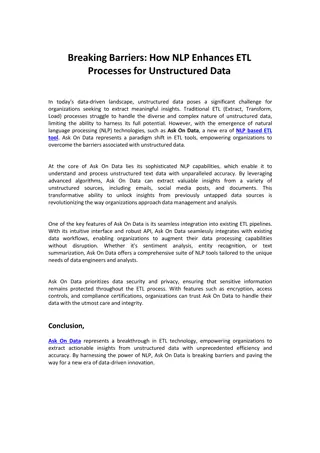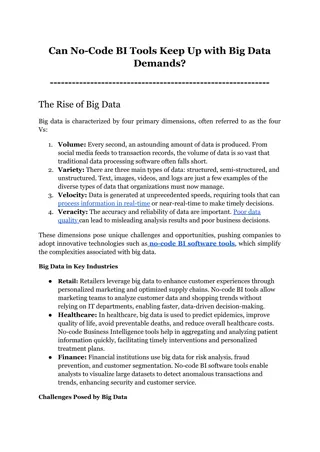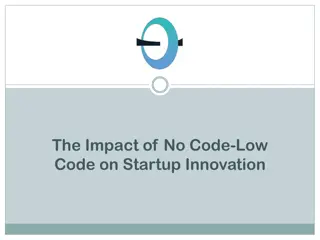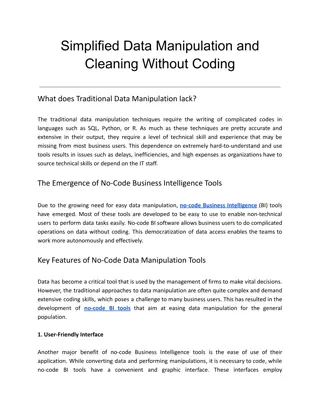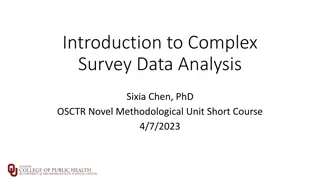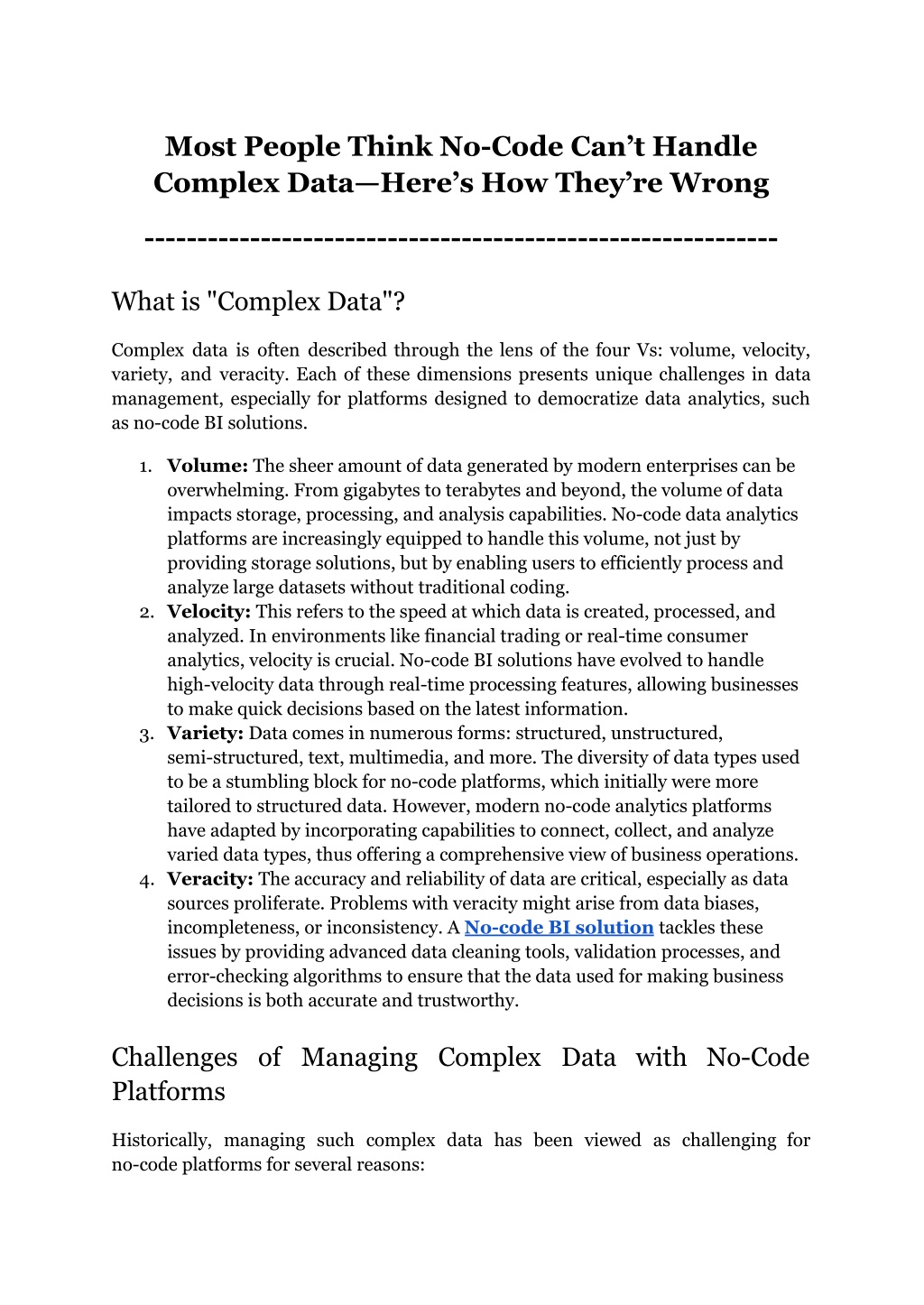
Most People Think No-Code Can’t Handle Complex Data—Here’s How They’re Wrong
Challenges the common misconception that No-code data analytics platforms are unsuitable for complex data management. By exploring the advanced capabilities of modern no-code BI solutions, such as dynamic data integration, sophisticated processing tools, and scalable architectures, we demonstrate how these platforms are not only capable but also powerful in handling complex data tasks.
Download Presentation

Please find below an Image/Link to download the presentation.
The content on the website is provided AS IS for your information and personal use only. It may not be sold, licensed, or shared on other websites without obtaining consent from the author. Download presentation by click this link. If you encounter any issues during the download, it is possible that the publisher has removed the file from their server.
E N D
Presentation Transcript
Most People Think No-Code Cant Handle Complex Data Here s How They re Wrong ------------------------------------------------------------ What is "Complex Data"? Complex data is often described through the lens of the four Vs: volume, velocity, variety, and veracity. Each of these dimensions presents unique challenges in data management, especially for platforms designed to democratize data analytics, such as no-code BI solutions. 1. Volume: The sheer amount of data generated by modern enterprises can be overwhelming. From gigabytes to terabytes and beyond, the volume of data impacts storage, processing, and analysis capabilities. No-code data analytics platforms are increasingly equipped to handle this volume, not just by providing storage solutions, but by enabling users to efficiently process and analyze large datasets without traditional coding. 2. Velocity: This refers to the speed at which data is created, processed, and analyzed. In environments like financial trading or real-time consumer analytics, velocity is crucial. No-code BI solutions have evolved to handle high-velocity data through real-time processing features, allowing businesses to make quick decisions based on the latest information. 3. Variety: Data comes in numerous forms: structured, unstructured, semi-structured, text, multimedia, and more. The diversity of data types used to be a stumbling block for no-code platforms, which initially were more tailored to structured data. However, modern no-code analytics platforms have adapted by incorporating capabilities to connect, collect, and analyze varied data types, thus offering a comprehensive view of business operations. 4. Veracity: The accuracy and reliability of data are critical, especially as data sources proliferate. Problems with veracity might arise from data biases, incompleteness, or inconsistency. A No-code BI solution tackles these issues by providing advanced data cleaning tools, validation processes, and error-checking algorithms to ensure that the data used for making business decisions is both accurate and trustworthy. Challenges of Managing Complex Data with No-Code Platforms Historically, managing such complex data has been viewed as challenging for no-code platforms for several reasons:
Technical Limitations: Initially, No-code Business Intelligence tools were primarily designed for simpler, more straightforward tasks. As the demand for more sophisticated operations grew, these platforms had to evolve significantly to incorporate functionalities that could handle complex data efficiently. Integration Capabilities: Integrating diverse data sources into a single coherent platform was another hurdle. No-code BI solutions have addressed this by developing enhanced APIs and connectors that allow seamless integration of various data sources, making it easier for users to access and synthesize information across systems. User Skill Levels: No-code platforms are designed to be user-friendly, catering to users without technical expertise. Balancing simplicity with the ability to perform complex data operations has required continuous improvement of user interfaces and functionalities, ensuring that they remain intuitive yet powerful. Scalability Concerns: Scaling a no-code BI solution to accommodate growing data needs and increasingly complex operations is a significant challenge. As businesses grow, their data demands evolve, requiring more robust solutions. No-code Business Intelligence platforms have responded by enhancing their architecture to support scalability not just in terms of data volume, but also in handling more complex analytics and larger user bases without degradation in performance. Security and Compliance: With the increase in data breaches and stringent regulations, security remains a top priority. Initially, no-code platforms had to rapidly develop and implement comprehensive security measures to ensure data integrity and compliance with regulations such as GDPR and HIPAA. Today, no-code analytics platforms incorporate advanced security features, including role-based access controls, data encryption, and audit trails, which help maintain data security and trust. Core Features of No-Code Platforms That Handle Complex Data No-code Business Intelligence platforms have emerged as a powerful tool in business intelligence and analytics, helping organizations to manage complex data without extensive coding knowledge. Here, we delve into the essential features that empower these platforms to effectively handle complex data scenarios: Dynamic Data Integration Seamless Connection Across Diverse Data Sources: No-code data analytics platforms are designed to integrate a wide array of data sources, enhancing their utility in diverse business environments. For example, they can connect to Internet of Things (IoT) devices, which generate vast amounts of real-time data. By
integrating this data, companies can monitor operational efficiency and predictive maintenance without manual intervention. Social Media and Real-Time Data Streams: A No-code BI solution adeptly handles data from social media streams, enabling businesses to tap into consumer sentiments and market trends as they unfold. This capability is critical for marketing and customer service strategies that rely on up-to-the-minute data to drive decisions. Traditional and Cloud-Based Databases: Integration with both traditional databases like SQL and modern cloud-based services such as AWS or Google Cloud is a hallmark of advanced no-code platforms. This flexibility allows users to pull historical and current data from multiple repositories, providing a comprehensive view for analysis without needing manual coding. Advanced Data Processing Automated Data Transformations: One of the standout features of no-code BI tools is their ability to automate routine data transformations. This includes tasks like normalizing data formats, converting timestamps, or recalculating metrics. Automation speeds up data preparation, a typically time-consuming process, freeing up users to focus on strategic analysis. Sophisticated Filtering and Aggregation: No-code platforms offer advanced filtering options that allow users to sift through large datasets to find relevant subsets of data. Additionally, aggregation capabilities enable users to summarize these data points into actionable insights. For example, a no-code BI solution can automatically aggregate sales data by region, product, or time period, facilitating quick and easy performance evaluations. Complex Data Handling with Simple Interfaces: Despite their underlying complexity, these platforms maintain non-technical users to perform sophisticated data analysis. This accessibility is crucial in democratizing data analytics across an organization, ensuring that more employees can make data-driven decisions. user-friendly interfaces that allow Scalability and Performance Handling Large Data Sets: Modern no-code data analytics platforms are built to scale with the needs of a growing business. They can handle large volumes of data from thousands to millions of records without a hitch. This scalability ensures that as an organization grows, its data analysis capabilities can grow with it, without the need for significant additional investment in IT infrastructure. Performance Optimization: These platforms are optimized for performance, ensuring that even complex queries across large datasets are processed quickly. This is achieved through the use of efficient data indexing, query optimization techniques,
and leveraging cloud infrastructures that can dynamically allocate resources based on demand. Minimized Need for Manual Coding: By reducing the reliance on manual coding, no-code platforms enable faster adaptation to business changes. Teams can modify data workflows and reporting processes with minimal IT involvement, which is particularly valuable in dynamic business environments where speed and agility are at a premium. Technical Insights: How No-Code Works with Complex Data As No-code Business Intelligence platforms gain traction in the realm of business intelligence and data analytics, it s crucial to understand the technological backbone that allows these tools to handle complex data tasks efficiently. This segment dives into the architecture and algorithms inside the no-code BI solution, highlighting the role of artificial intelligence (AI) and machine learning (ML) in enhancing these platforms. Architectural Foundations of No-Code Platforms Modular Design: At the core of no-code platforms lies a modular architecture that allows for the flexible combination of various functionalities according to specific data tasks. This design enables users to drag and drop different modules such as data importers, processors, and visualization tools into a coherent workflow without writing code. Each module is optimized to handle specific aspects of data management, from ingestion and cleaning to analysis and reporting. Data Flow Engines: No-code BI solutions are equipped with advanced data flow engines that manage the movement of data through different processing stages. These engines are designed to efficiently handle large volumes of data, ensuring that data flows smoothly between modules without bottlenecks. By automating data routing and task execution, these engines reduce the complexity and error potential inherent in manual processes. AI and Machine Learning Automated Data Cleaning and Preparation: AI plays a critical role in automating the time-consuming tasks of data cleaning and preparation. Machine learning algorithms can detect inconsistencies, outliers, and missing values within large datasets and automatically apply fixes or flag issues for review. This not only speeds up the preparation phase but also enhances the accuracy of the data being analyzed.
Predictive Analytics and Pattern Recognition: Machine learning algorithms are integral to no-code data analytics platforms, enabling predictive analytics and pattern recognition capabilities. These algorithms analyze historical data to forecast trends, identify anomalies, and generate insights that would be difficult and time-consuming to uncover manually. For instance, a no-code BI solution might use time-series forecasting to predict inventory needs or customer demand, helping businesses optimize their operations. Optimization of Data Processes: Beyond analytics, AI and ML are also used to continuously optimize data processes on no-code platforms. Adaptive algorithms learn from each operation, improving the efficiency of data transformations and queries over time. This learning capability ensures that no-code platforms become more effective as they are used, adapting to the unique data environment of each business. AI-Driven Automation Decision Support Systems: By integrating AI-driven decision support systems, no-code BI tools help users make informed decisions quickly. These systems analyze the data and present recommendations or insights directly, aiding in rapid decision-making processes typical in dynamic market conditions. Natural Language Processing (NLP): Advanced no-code platforms incorporate NLP capabilities, allowing users to interact with data using natural language queries. This significantly lowers the barrier to data analytics, enabling even non-technical team members to generate reports and gain insights simply by asking questions in plain language. Conclusion The prevailing myth that no-code platforms can't handle complex data is increasingly being disproven by the advancements in no-code technology. As we've seen, modern no-code BI solutions, equipped with dynamic integration capabilities, sophisticated data processing tools, and scalable architectures, are more than capable of managing the complexities of big data. These platforms not only streamline complex data tasks but also empower a broader spectrum of users to engage with data analytics, enhancing decision-making across entire organizations. For businesses looking to explore the potential of no-code solutions, starting with a robust platform like Grow can be a transformative step. Grow's no-code data analytics platform is designed to handle complex data with ease, offering a range of tools that automate and optimize data processes through AI and machine learning. By taking advantage of Grow s 14-day free trial, businesses can experience firsthand how no-code tools can enhance their data handling capabilities without any financial commitment.
Additionally, to make an informed decision about adopting a no-code analytics platform, it's valuable to consider peer reviews and user experiences. Prospective users can visit "Grow.com Reviews & Ratings 2024 TrustRadius" to read firsthand accounts of how Grow has enabled businesses to efficiently manage complex data and gain actionable insights, further debunking the myth that no-code platforms are not up to the task. By embracing no-code BI solutions like Grow, businesses not only streamline their data processes but also foster a culture of data-driven decision-making. Take the first step towards transforming your data management strategy by exploring Grow s capabilities today unlock the power of your data with no-code solutions.



